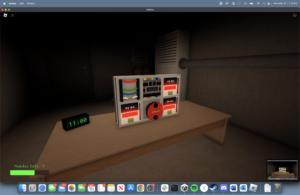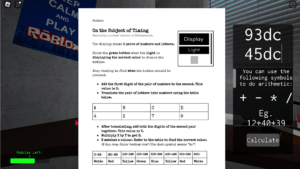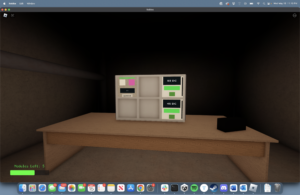Defusal is a game (or “experience”) developed by group Polygon Interactive utilizing the platform and engines by the publisher: Roblox. The game is targeted towards teenagers to young adults, but open to all given the platform. Defusal is heavily inspired by (ahem, totally not a direct copy of) the more popular and well-known game Keep Talking and Nobody Explodes.
The game is centered around defusing a bomb. Scary! The catch is that this operation is purely multiplayer where the team is split into two groups: defusers and instructors. Defusers describe puzzles they see located on the device giving specific information about each to the instructors. The instructors have a large manual that they use to solve the puzzles being described by the defusers. (Seen below.)


(Left: Defuser’s POV; Right: Instructor’s POV.)
This pairing is an ultimate test of communication and speed. While the puzzles range in difficulty, many are relatively simple. Additionally, how to solve each puzzle is precisely written! However, the additional constraints on what each player can see/do and how much time they have to realistically solve each challenge serve to heighten the difficulty of even the simplest puzzles.
So how do the mechanics of the puzzles and the space they take place in influence the experience of the game if many of them are rather simple? Puzzles influence the experience of the game in several ways: the first of which requires of players to develop strong mental maps; the second being they require players to develop feelings of familiarity; the third being they are the core roadblock to progression in the game.
To begin with the idea of developing strong mental maps (a common skill built into games): how does the puzzles go about doing this? The puzzles draw from the imposed mechanical design of limited information. Each player lives in their own world and space yet simultaneously co-exist. Both players have to interpret and build a thorough mental schema for how to approach each puzzle on the device. This requires players to develop and master ways of communicating each puzzle’s set-up and information. There can be a lot of different types of puzzles so building this mental model is important. For example, if we refer back to the defuser’s POV, we can see that there were wires, a button, and a pair-based text module.
 \
\
While the description of “wires” and “button” are generally okay since there weren’t other modules that shared those components, the “pair-based text module” leaves a lot of ambiguity. If you are with a more experienced player and they say they see the “puzzle with the numbers and letter pairs” they will likely understand precisely, but with newcomers you may instead see them describe it with less important details. This is a two-way street since instructors can also ask for specifics to narrow down the options. What information they ask for becomes relevant for describing future tasks and further helps build a mental model for what is actually important in the game for generally describing each puzzle.
Once the mental model is been solidified a bit, puzzles force players to recognize patterns and familiar constructs. Our device to defuse which I captured pictures for ended up having 5 of the same type of puzzle:


This familiarity allows for players to draw on their mental model and prior knowledge to quickly iterate and hasten their progress in the game. Being familiar with more puzzles directly correlates to improved skill overall and eventually mastery of the game. More difficult modes become increasingly accessible based on these efforts, which changes how players perceive and experience the game holistically.
Lastly, the lowest hanging fruit to pick, the puzzles are the game itself. The puzzles directly shape the game and if they are too easy or too hard, the game would become much less fun. It relates back to Anthony’s presentation on game balancing. If every device were just based on cutting a singular wire or if every device was centric on doing extreme amounts of time-based puzzles that requires perfection down to the second, very few people would enjoy it.
These three principles are what makes the game fresh, replayable, and an interactive experience centric around puzzles essentially only puzzles.


